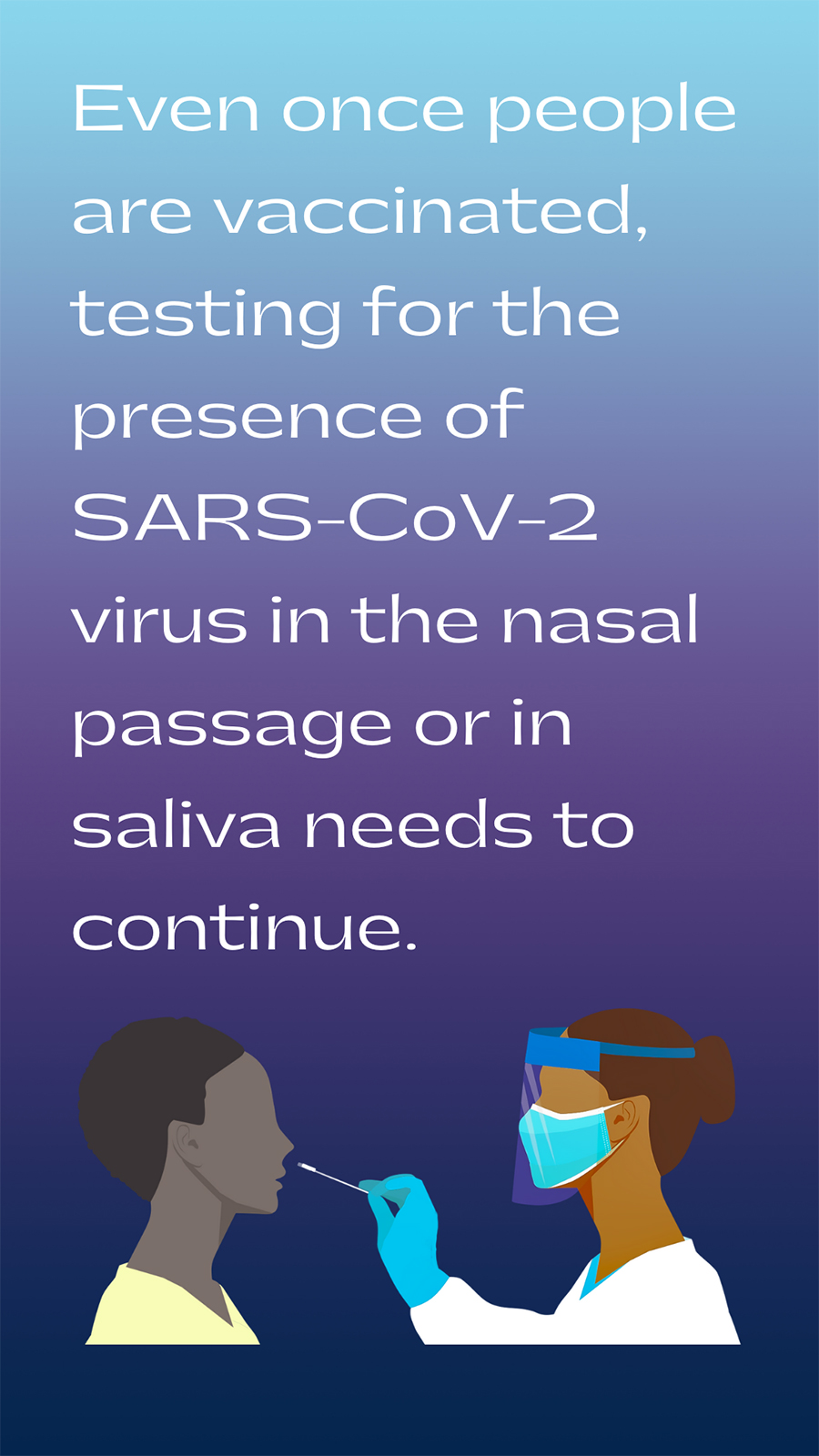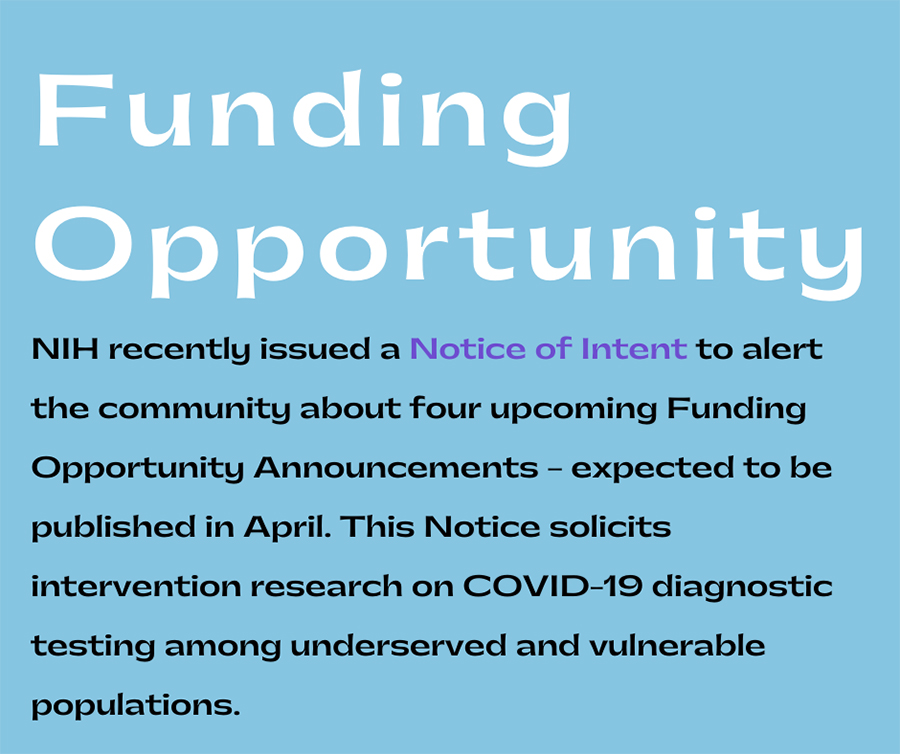
This piece was authored in collaboration with leadership across NIH and represents a unified effort to meet the testing-related challenges presented by the COVID-19 pandemic with excellence and innovation.
Over the past year, our team of NIH leaders has used this blog to report on an initiative called Rapid Acceleration of Diagnostics, or RADxSM for short. The RADx initiative includes five key components designed to address the coronavirus (COVID-19) pandemic by ensuring that companies make and distribute tests to detect SARS-CoV-2, the virus that causes COVID-19; develop ways to deliver those tests and results directly to people—independent of their age, race, ethnicity, disability, financial status, or where they live; and invest in innovative approaches to detect emerging and spreading infections. NIH has also added a new component to RADx – to find ways to understand and address the concerns of people worried about testing, vaccine safety, and efficacy. The RADx components are described below.

RADx Underserved Populations (RADx-UP) is a significant investment to bring testing to traditionally underserved communities. Last fall, we launched a nationwide program, involving more than 60 research teams and a Coordination and Data Collection Center, to better understand the needs of people in a wide range of communities, and to ensure that underserved communities have adequate access to COVID-19-testing, and return results in ways that are actionable to promote health. We estimate that up to 500,000 people will participate in the study in more than 33 states, the District of Columbia, and Puerto Rico—representing a broad spectrum of communities of color and socially vulnerable populations. RADx-UP is collaborating with the NIH Community Engagement Alliance (CEAL) Against COVID-19 Disparities to further amplify the NIH’s focus on communities hardest hit.

Through two programs within the RADx initiative — RADx Tech and RADx ATP (Advanced Technology Platforms)—researchers aim to accelerate evaluation, validation, and scale up of promising COVID-19 testing technologies for laboratory, point-of-care and at-home settings, and provide guidance on when to test . More than 700 applications were submitted to the programs’ unique “innovation funnel” review process over a three-month period. To date, 29 projects have progressed through multiple phases of review to receive contracts for expansion of manufacturing and clinical studies. RADx Tech and RADx-ATP-supported companies have increased COVID-19 testing capacity across the United States by more than 150 million tests and compressed the typical multi-year tech commercialization process into approximately six months.

RADx Radical (RADx-rad) is designed to support innovative research programs focused on developing novel and potentially “radical” ways to detect infectious disease from SARS-CoV-2 or other agents, and evaluate community spread. Unlike the RADx Tech and RADx-ATP programs, which focus on developing technologies that can be delivered in the near term, projects within RADx-rad may require additional time for development. While some of these projects may not be available in the near term to respond to the current COVID-19 pandemic, they could be potentially applicable to deploy quickly for future pandemics. Currently, RADx-rad projects involve a broad array of activities that range from analysis of wastewater for infectious agents, like SARS-CoV-2, all the way to the development of artificial sensory devices to detect volatile organic compounds that uniquely emanate from individuals carrying an infection. Most notably, RADx-rad provides a mechanism for giving radical ideas a chance to demonstrate efficacy and promise.

A central focus of the RADx data management strategy is the safe management of data that is collected, standardized, and harmonized as a result of the implementation of new and novel testing methodologies. The close collaboration with RADx data and coordinating centers to develop and implement common data elements and models is important to the success of this strategy; along with the facilitation of harmonized data sharing on a secure cloud-based data platform. This platform, the RADx data hub, will provide a research data repository of curated and de-identified RADx COVID-19 data—allowing researchers to find, aggregate, and perform data analysis. The data hub will also enable researchers to share results of their analyses (citing relevant data) with collaborators and the external community; and provide a portal where researchers can find additional data and information from other NIH-supported COVID-19 resources.
Although programs such as RADx have helped create COVID-19 tests and make them more available to the public, our work and your work is not done.

Vaccines will go a long way in bringing protections to society and researchers are still learning how well the vaccine prevents people from spreading the virus. Public health measures, such as wearing face masks and frequent testing, continue to be important in efforts to contain this pandemic and address its consequences on society. Testing resources and places to get tested have become more accessible, but still need to be more widely available, affordable, and convenient. Even once people are vaccinated, testing for the presence of the SARS-CoV-2 virus in the nasal passage or in saliva needs to continue. This will help detect and identify new variants, discover asymptomatic infections, and help reduce community spread. As case rates decrease, these strategies will be complemented by the expansion of contact tracing to control the pandemic.
As vaccines help reduce the overall national prevalence of COVID-19, it’s important to pay attention to local trends in the percent of people who test positive and continue to test accordingly. Baseline testing should be adjusted to match regional and community needs and to prevent surges in community transmission. As the prevalence of positive tests decreases in a population, it will become cost-effective to test pooled samples from multiple donors by highly sensitive molecular tests, followed by testing of individual samples from any pools that are positive. Access to inexpensive rapid antigen tests authorized by FDA for self-testing and serial screening will continue to expand. Finally, tests that are designed to detect the presence of specific SARS-CoV-2 variants will become available. Ultimately, we’ll need to have baseline testing platforms and protocols in place to identify future outbreaks, detect other pathogens, and leverage these advances for accessible testing and treatment of other diseases.

The three W’s will remain an important part of society for some time:
- Wash your hands often and for at least 20 seconds.
- Wear your mask correctly for maximum protection.
- Watch your distance and avoid indoor gatherings without masks.
People need to be aware of and encouraged to sign up and use the exposure notification apps created by public health authorities and available on iPhone and Android devices. This secure electronic effort complements contact tracing and appears to be effective at saving lives by alerting people if they have been exposed to COVID-19 and providing guidance for further action.
Our response to COVID-19 is built not only on lessons learned over the past year, but also on the sustained investment in biomedical research of the past decades. We are proud of our agency and researchers for their efforts to mobilize and tackle this destructive pandemic. We are also very grateful to our research participants in communities around the country.
We’re interested in hearing how we could better serve the public.

Top Row (left to right):
Diana W. Bianchi, M.D., Director, Eunice Kennedy Shriver National Institute of Child Health and Human Development
Patricia Flatley Brennan, R.N., Ph.D., Director, National Library of Medicine
Noni Byrnes, Ph.D., Director, Center for Scientific Review
Gary H. Gibbons, M.D., Director, National Heart, Lung, and Blood Institute
Second Row (left to right):
Joshua Gordon, M.D., Ph.D., Director, National Institute of Mental Health
Susan Gregurick, Ph.D., Associate Director for Data Science and Director, Office of Data Science Strategy
Richard J. Hodes, M.D., Director, National Institute on Aging
Helene Langevin, M.D., Director, National Center for Complementary and Integrative Health
Third Row (left to right):
Jon R. Lorsch, Ph.D., Director, National Institute of General Medical Sciences
George A. Mensah, M.D., Division Director, National Heart, Lung, and Blood Institute
Eliseo J. Perez-Stable, M.D., Director, National Institute on Minority Health and Health Disparities
William Riley, Ph.D., Director, NIH Office of Behavioral and Social Sciences Research
Bottom Row (left to right):
Tara A. Schwetz, Ph.D., Associate Deputy Director, National Institutes of Health
Bruce J. Tromberg, Ph.D., Director, National Institute of Biomedical Imaging and Bioengineering
Nora D. Volkow, M.D., Director, National Institute on Drug Abuse
Richard (Rick) P. Woychik, Ph.D., Director, National Institute of Environmental Health Sciences

 BACK TO TOP
BACK TO TOP